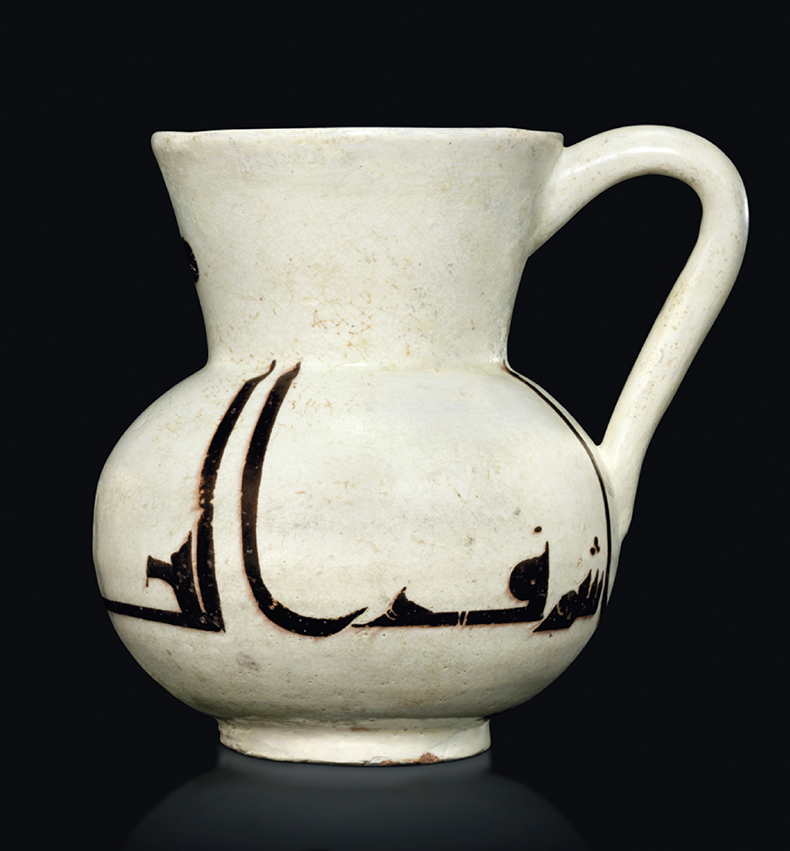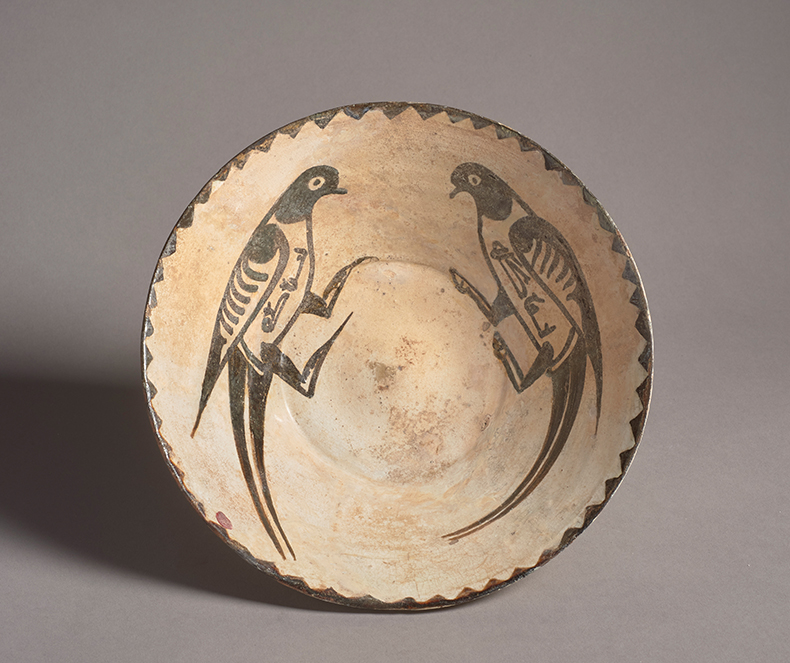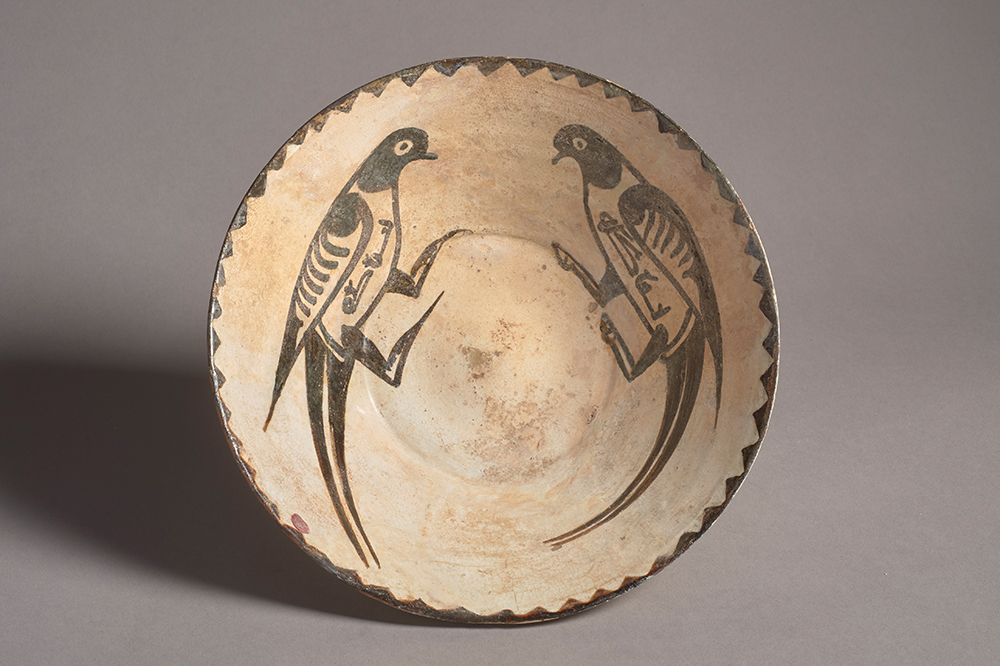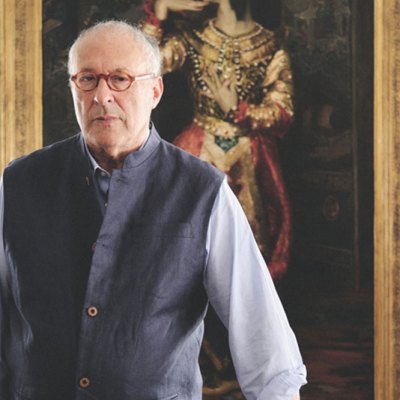From the December 2024 issue of Apollo. Preview and subscribe here.
During the almost 800 years that the Arab Muslim Abbasid caliphate held nominal sway from North Africa to India and the Aral Sea (750–1517), there were many disruptive interludes. The Samanid Empire, which lasted from 819 to 1005, was one of a handful of Iranian Muslim dynasties that contributed to what is known as the Persian Renaissance. From their capitals in Samarkand and later Bukhara, the Samanids controlled territories in Khorasan and Transoxiana – eastern Iran and parts of what are now Afghanistan, Uzbekistan, Kyrgyzstan and Kazakhstan.
They promoted Persian language and literature as well as the arts and science, drawing scholars such as the court poet Rudaki and the philosopher and physician Ibn Sina (Avicenna). Among the most striking cultural artefacts surviving from their rule are two types of pottery. The first is known as epigraphic ware – earthenware vessels with elegant white slip, decorated with brownish or purplish, sometimes red, calligraphy. These were long known about and found in Nishapur, in north-east Iran, but also in Samarkand and other Samanid cities, as far east as Otrar in southern Kazakhstan; many were unearthed in licensed digs during the 1930s and ’40s. They are inscribed with Arabic proverbs in ‘eastern’ Kufic script, arranged radially, and sometimes with geometric or rosette patterns. The second type was unknown until archaeological excavations in Nishapur led by the Metropolitan Museum of Art between 1935 and 1940, which unearthed a type of vibrant polychrome buffware (a fine, white clay body) densely decorated with figures, flowers and animals. The bowls are less angular, more rounded, with colour combinations of green, yellow and black under a transparent glaze. While the Nishapur buffware reflects in its varied iconography the richness of Samanid culture at the time, the austere epigraphic pieces, which use an Arabic script associated with the Qur’an, reflect the ruling elite’s Sunni beliefs. Scholars have traced antecedents in Abbasid Iraqi cobalt blue-on-white vessels, some with inscriptions, and in the white porcelaneous wares arriving in the Islamic world from China by the early ninth century. Still, in the words of one scholar, ‘These [epigraphic] vessels are like no other type of pottery that is produced anywhere in the Islamic world before or since the Samanid period, and they bear no aesthetic relation to the major pottery types that coexisted with them.’
Earthenware jug made in Central Asia in the 9th/10th century. Christie’s London, £125,000. Photo: Christie’s Images Ltd, 2024

Both types of pottery are collectable, but it is the austere white epigraphic wares, displayed in many major museum collections, that are most popular. Diana Luber at London gallery Sam Fogg comments: ‘There has been a steady interest in this type of ware since Islamic ceramics began to appear on the European market and exit the great private collections in greater numbers at the end of the 20th century.’ Arthur Lane, in his book Early Islamic Pottery (1947), praised their ‘stark and moving beauty’; Behnaz Atighi Moghaddam, a specialist in the Islamic department of Christie’s London, confirms that for collectors pursuing masterpieces, ‘These fit into that category.’ Interest grew during the pandemic, as people discovered the works online: ‘We have new buyers in the Middle East, and we are encouraging younger people to see the appeal of these beautiful wares.’
Christie’s notes, in its catalogues, that the United States ‘prohibits dealings in and import of Iranian-origin “works of conventional craftsmanship” (such as carpets, textiles, decorative objects, and scientific instruments) without an appropriate licence’ – which has in effect killed the US market. Elsewhere, museums and private collectors must observe the UNESCO 1970 Convention, requiring documented provenance outside Iran (and associated areas) before that date – a restriction that has helped to maintain prices, if not at the peak seen before the financial crash of 2008. In October 2020 a large dish, characteristically conical and thinly potted, with spare black Kufic inscriptions, sold for £93,750 at Christie’s London, against an estimate of £80,000–£120,000, despite a few visible repairs (it had sold at Sotheby’s London in 2007 for £86,900). Moghaddam says, ‘Condition is very important but it is not uncommon for there to be historic repairs.’ In the same sale, a rare jug soared to £125,000, over four times the top estimate of £30,000. Frankie Keyworth, a specialist in Islamic art at Sotheby’s, says that, beyond the most refined classic pieces, ‘any deviation from the common production attracts collectors looking for exceptional examples of the type.’ A conical dish with prawn-pink calligraphy on cream slip sold at Sotheby’s London in April 2008 for £120,500 (estimate £40,000–£50,000). Another variant is figural, polychromatic slip-painted ware offering ‘closely packed compositions of fantasy and humour’. These pieces, Keyworth says, ‘are rarer and appear less frequently on the market so are sought after when they do come up for sale’. She cites from the same 2008 sale a monumental bowl decorated with polychrome fish and stylised Kufic script which sold for £74,900 (estimate £30,000–£40,000). More recently, in March 2021, a rare bichrome Samanid pottery bowl made in Nishapur or Samarkand in the 10th century fetched £18,900 (estimate £15,000–£25,000) at Sotheby’s London. Smaller or less immaculate wares are available for far lower sums.
Earthenware bowl with two birds and inscriptions made in Nishapur, Iran in the 10th century. Galerie Kevorkian (€10,000–€50,000). Photo: Thierry Ollivier; © Galerie Kevorkian

Corinne Kevorkian, the third generation of her family at Galerie Kevorkian in Paris, will take two white slipware bowls to TEFAF Maastricht, one decorated with calligraphy, the other with two birds. She says, ‘The highest quality pieces of this type are sought after internationally by people interested in a whole range of antiquities. They are timeless. What matters most are condition and aesthetic quality.’ Irène Momtaz of London gallery Momtaz Islamic Art says that collectors choose according to ‘the quality of glaze and elegance and boldness of the calligraphy’, but provenance is also important. The meaning of the inscriptions does not affect value.
The market for figural buffware is wholly different. These vessels are valued much lower at auction. According to Keyworth, ‘The group has largely been considered a less sophisticated production than calligraphic and figural examples in slipware.’ Examples are less commercial than slipware, ‘despite the boisterous polychrome palettes and array of figural, floral and animal motifs’. Keyworth’s assessment should be tempered by the observation of Sophie Howell, Islamic Art specialist at Apollo Art Auctions: ‘Buffware ceramics that feature bold figural imagery from classical Persian epics alongside Nestorian Christian symbolism, which highlight this cultural fusion and reveal a “trans-cultural” aesthetic, are of particular interest to academics, due to their complex sociological storyline.’
Sam Fogg gallery mounted an impressive display of figural buffware in 2022, arguing that ‘the emergence of these remarkable bowls from the excavations was a revelation that completely altered the established perception of Samanid ceramics production, and ultimately re-defined the role of figuration in early medieval Islamic ceramics writ large.’ Luber agrees with Keyworth that ‘the figural buffware is interesting to collectors but has less market value than the epigraphic wares.’ The best buffware, she suggests, ‘usually commands five-figure prices, though it varies depending on quality and style of decoration, condition and provenance’. The gallery has buffware available, as well as a fine Samanid epigraphic bowl made in Samarkand in the 20th century, one highlight of their Frieze Masters presentation. ‘It is great material for a focus exhibition,’ opening out an intriguing field for enthusiasts.
From the December 2024 issue of Apollo. Preview and subscribe here.



